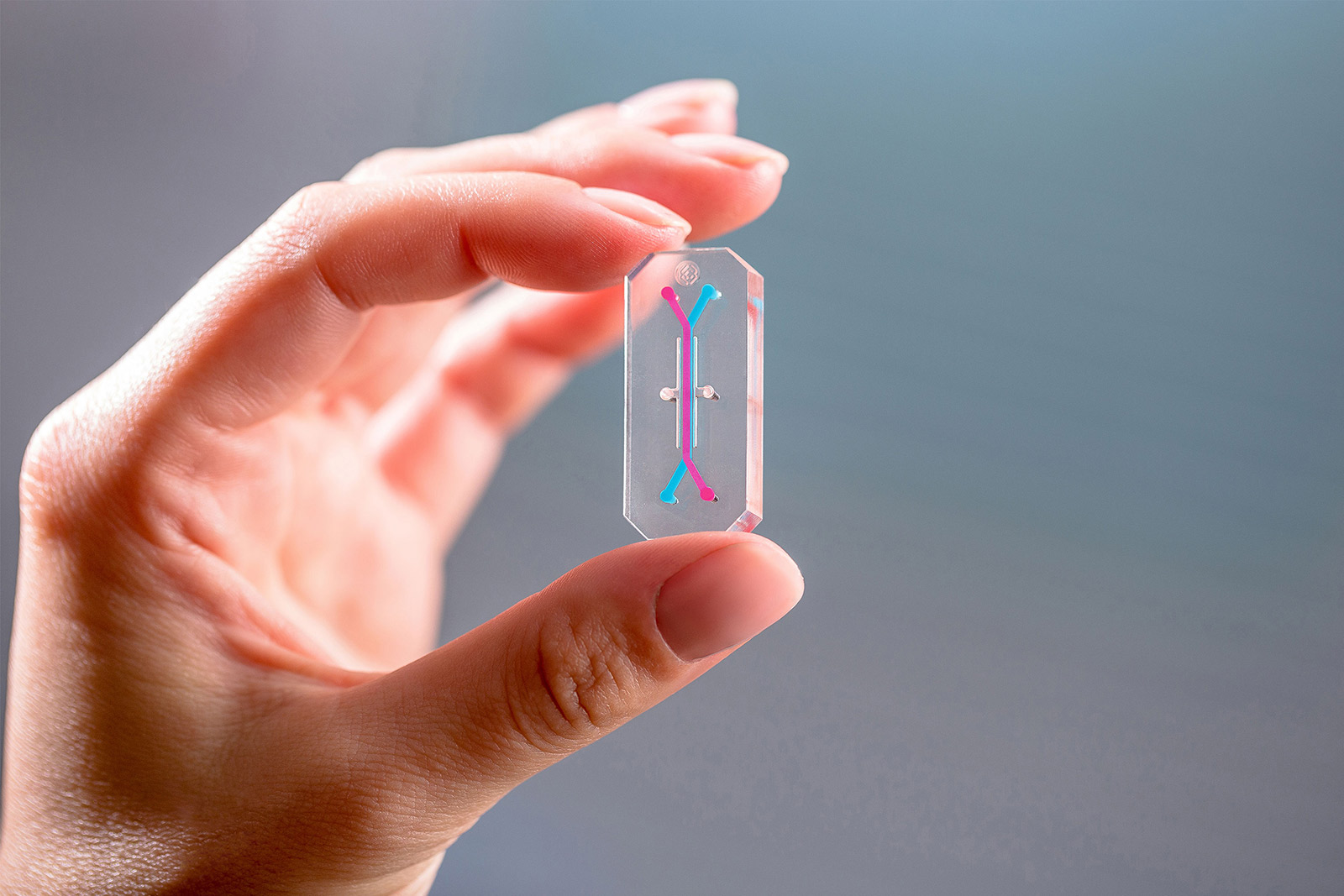Drug discovery has always been a complex and costly process, with countless potential treatments failing before they ever reach patients. But what if there was a way to predict a drug’s success more accurately, reduce reliance on animal testing, and speed up development? That’s exactly what organ-on-a-chip technology promises to deliver.
These groundbreaking microdevices replicate the functions of human organs, offering a more precise and ethical alternative to traditional methods. By mimicking the behaviour of lungs, hearts, or kidneys on a microscopic scale, they’re transforming how researchers test drugs and understand diseases. For scientists and pharmaceutical companies, this has become an exciting revolution!
Let’s Look at Organ-On-A-Chip Technology
Organ-on-a-chip technology merges biology and engineering to recreate the environment and functionality of human organs at a microscopic level. These advanced systems offer predictive insights into how drugs interact within a living body, replacing less reliable methods of current testing.
What Are Organ-On-A-Chip Models?
These are small, translucent devices that mimic the physical and biological environment of human organs. Inside them, live cells grow within channels that simulate the tissue and flow dynamics of organs such as the liver or lungs. You might think of it as holding a working replica of an organ in the palm of your hand. They provide real-time responses under experimental conditions, allowing researchers to observe complex biological processes up close.
Organ Chip Research Innovation
Advances in microfluidics and tissue engineering have driven transformative progress in this field. Scientists design chips to recreate organ-specific functions, like how a kidney filters waste or how the intestinal lining absorbs nutrients. Research teams pair these devices with data modelling to study diseases in a controlled manner. While still in evolution, this innovation bridges the gap between preclinical and clinical testing, reducing reliance on animal models while improving human relevance.
Key Features And Capabilities
These chips feature microchannels lined with human cells, facilitating proper nutrient and oxygen flow. They replicate critical physiological processes, such as cellular communication or vascular responses. Their compact structure ensures precise manipulation, enabling targeted drug testing. Multiorgan systems let you examine interactions between organs, such as liver metabolism affecting drug efficacy in other tissues. These capabilities revolutionise your ability to benchmark toxicity, efficacy, and personalised responses without traditional limits.
Revolutionising Drug Discovery
Organ-on-a-chip models are transforming how you approach drug discovery. These intricate devices offer insights that traditional methods often miss, setting a new standard in research.
Improved Accuracy In Drug Testing
You might question the reliability of lab-grown environments, but these chips replicate human organ functions with precision. They create microenvironments where human cells behave like they would in your body—responding to stimuli, sustaining nutrient flows, and mimicking tissue dynamics. When testing new drugs, this accuracy means you can better predict how treatments interact with humans, bypassing uncertainties common in animal models. For example, liver-on-a-chip devices have revealed specific toxicities long before typical preclinical studies would uncover them. This level of detail reduces later-stage clinical trial failures.
Reducing Animal Testing In Research
Animal testing has long stood as a cornerstone of research, but the ethical and scientific limitations are becoming harder to justify. With organ-on-a-chip models, you engage with human cells directly, achieving data that aligns more closely with your goals. These human-cell-based systems replace animals in evaluating toxicity or treatment efficacy, cutting unnecessary suffering. Lung-on-a-chip devices, for instance, show how drugs impact respiratory tissues in real time without relying on animal subjects. This shift makes your results more humane and scientifically relevant.
Accelerating Drug Development Processes
Drug development cycles are often bogged down by lengthy preclinical stages. Using organ-on-a-chip models, you streamline these processes, as the chips provide faster analysis and earlier identification of potential treatment issues. Interaction studies across multiple chips—like heart and kidney systems—allow you to simulate complex body responses, speeding up decision-making. When toxicity or inefficacy is identified at earlier phases, your resources can move to more promising candidates, minimising wasted time and costs. The result is more efficient progression from concept to clinical trials.
Applications In Various Therapeutic Areas
Organ-on-a-chip models have redefined how diseases are studied, offering unparalleled precision across several medical fields. Their adaptability addresses diverse challenges, making them invaluable in drug discovery.
Oncology And Cancer Research
You know the urgency surrounding cancer research. Organ-on-a-chip technology lends itself to this realm by simulating tumour microenvironments with remarkable accuracy. These chips replicate cancer-specific factors like hypoxia, angiogenesis or drug resistance, allowing tailored exploration of anti-cancer drugs. Models of individual tumour growth also let you personalise treatments, ensuring efficacy. The interaction between cancer cells and healthy tissues might reveal hidden insights, reshaping preclinical oncology studies. You’re able to replace unreliable animal models with human-based systems, boosting confidence in predictions.
Neurological Disorder Studies
When it comes to your understanding of the brain, conventional study methods are often limited. Brain-on-a-chip devices emerge as powerful alternatives for probing neurological conditions like Alzheimer’s, Parkinson’s or epilepsy. These models replicate the blood-brain barrier and neuronal networks, which are otherwise difficult to recreate. You focus on intricate cell signalling or drug permeability, gaining insights animal models may miss. Neurodegenerative disease progression and testing of therapeutic interventions seem more accessible now. You’re bridging gaps in neuroscience using these specialised chips.
Cardiovascular Disease Modelling
Cardiovascular diseases demand precise testing environments, and heart-on-a-chip devices deliver just that. These systems imitate dynamic conditions of human hearts, including electrical activity and blood flow. You analyse cardiac toxicity or drug effects under physiologically relevant conditions, enhancing preclinical test reliability. By adjusting chip designs, it’s feasible to model specific conditions like arrhythmias or valvular diseases, focusing on unique challenges. Chips even replicate the mechanical forces exerted on the heart, vital for assessing new drugs. You’re moving closer to targeting heart disease effectively.
Challenges And Limitations
Organ-on-a-chip models carry tremendous potential, yet they face several obstacles. These limitations pose questions about scalability, approval processes, and long-term integration into drug discovery.
Technical And Manufacturing Hurdles
Creating organ-on-a-chip devices isn’t as straightforward as it may seem. Precision engineering is crucial, and fabricating these intricate systems requires advanced expertise. You encounter difficulties in aligning cell behaviour with physiological functions. Manufacturing consistency is another major issue; producing chips at scale while retaining uniformity presents a challenge. Materials matter too. Ensuring biocompatibility without introducing unwanted variables complicates development further. Progress depends on refining these processes to deliver reliable, reproducible results across studies.
Regulatory And Validation Concerns
Approval processes for new technology always stir complexity. While organ-on-a-chip models show promise, regulatory validation still lags. Authorities enforcing standards struggle to adapt frameworks that account for this innovative technology. You might ask, how do these chips compare to pre-existing benchmarks? Validation processes demand rigorous comparison with traditional models. Global inconsistencies in regulatory expectations further complicate adoption. Establishing trust in these systems involves figuring cautious, slow-moving pathways that could delay practical applications.
Future Directions And Innovations
The potential of organ-on-a-chip models continues to expand, with things like innovative renal transporter models reshaping how you understand drug discovery and development. Emerging technologies and creative strategies are driving this evolution further, so let’s take a look:
Integration With AI And Machine Learning
Integrating organ-on-a-chip systems with AI and machine learning opens new doors. You might analyse massive datasets from chips with precision algorithms, revealing patterns impossible to see with traditional methods. Predictive models can anticipate drug responses, refining processes before testing begins. Tools driven by AI could help you automate monitoring, reducing errors while speeding analysis. These technologies also shine a light on unseen relationships between biological signals and drug behaviours, pushing research into uncharted territory. Are you considering how this fusion could rewrite your approach to preclinical research?
Expanding Model Diversity
Model diversity in this technology holds transformative power. Recreating organs like lungs or liver is just the beginning. You can step into the realm of patient-specific chips, creating models tailored to genetic profiles, disease states, or ethnic variations. What if you examined rare conditions or complex disorders more easily than before? Combining multiple organ systems might open doors to studying interactions between organs like never imagined. Each innovation strengthens the relevance of organ-on-a-chip testing, helping you address variations within human populations. Could these chips reflect the world’s medical complexity better than ever?
Last Thoughts
Organ-on-a-chip technology is reshaping how you approach drug discovery, offering unprecedented precision and ethical advancements. By bridging the gap between traditional methods and human biology, these models are paving the way for safer, faster, and more effective treatments.
While challenges remain, ongoing innovations and collaborations are steadily addressing these hurdles. As this field evolves, it holds the potential to redefine research standards and deliver breakthroughs that were once out of reach. The future of drug development is undeniably being shaped by this transformative technology.


